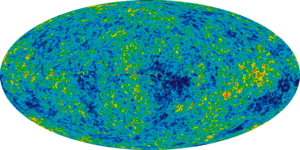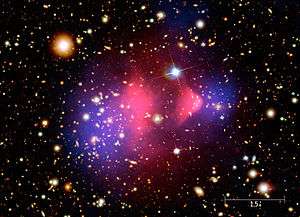Generic object of dark energy
Generic object of dark energy (also known as GEODE and GEODEs) refers to a class of non-singular theoretical objects that mimic black holes, but with dark energy interiors instead. They have been hypothesized to result from the collapse of very large stars by Leningrad physicist Erast Gliner at the Ioffe Physico-Technical Institute in 1966.[1][2][3][4][5][6][7][8] Such GEODEs appear to be black holes when viewed from afar but, different from black holes, these objects contain dark energy instead of a gravitational singularity.[4][5]
| Part of a series on | ||||
| Physical cosmology | ||||
|---|---|---|---|---|
 | ||||
|
Early universe
|
||||
|
Expansion · Future |
||||
|
Components · Structure
|
||||
| ||||
Contrary to classical black holes, GEODEs may intrinsically gain mass via the same relativistic effect responsible for the photon redshift. This results in a blueshift, which supplements and amplifies any mass gained through typical accretion processes.[9]
If the theorized GEODEs exist, then the expansion effect we attribute to dark energy could instead be an effect that we'd be able to attribute to this hypothetical species of black holes.[10] As of now, they remain speculative with no supporting evidence. The widely accepted, standard model of cosmology, postulates that dark energy is an inherent and constant property of spacetime, that would result in an eventual cold death of the universe.[11]
Examples of GEODEs
The following are a few hypothesized objects that are examples of GEODEs:
- Cosmologically embedded point-mass – proposed by George C. McVittie in 1933, this solution is one of the few known spherically symmetric strong solutions with realistic asymptotic behavior.
- Dark-energy star – proposed in 1980 by Robert B. Laughlin and George Chapline Jr. that the surface of a dark energy star actually represents a quantum critical transition of a superfluid vacuum.
- De-Sitter sphere – The simplest example of a GEODE is the De-Sitter sphere, first proposed by E. B. Gliner in 1966, as a non-singular end stage of stellar gravitational collapse.[12]
- Vacuum bubble – This is an example of a GEODE that is not formed from a gravitational collapse, and describes an isolated region of energized vacuum.
Stability
Dark energy objects are counter-intuitive and are not suspected to exist by mainstream scientists.[14] Some researchers have proposed models of stable configurations of dark energy stars. However, more research needs to be done to understand the nature and general properties of such compact objects.[15]
Detection
Despite theoretical basis for dark energy objects there has been no observational support of a GEODE scenario.[16] A few scientists suggest that the ringdown from the merger of a binary black hole can be analysed to differentiate between a conventional black hole and a GEODE.[17]
Implications for black hole size
The GEODE blueshift naturally produces the large masses observed in binary black hole mergers. Further, blueshift induces an adiabatic inspiral of Keplerian orbits that allows capture of wider binaries.
Additionally, some classes of GEODEs can grow by factors of ∼100× by redshift z ∼ 7. This can relieve tension between the observed masses of supermassive black holes in quasars at high redshift and their modeled formation timescales.
Implications for dark energy
According to researchers, if a small number of the oldest stars collapsed into GEODEs, rather than black holes, their contribution, on average, would result in the uniform dark energy that is observed today.[4] According to the researchers, "What we have shown is that if GEODEs do exist, then they can easily give rise to observed phenomena that presently lack convincing explanations. We anticipate numerous other observational consequences of a GEODE scenario, including many ways to exclude it. We’ve barely begun to scratch the surface.”[7][8]
Examples of non-singular black hole solutions that do NOT contain dark energy
- Black star (semiclassical gravity)
- Fuzzball (string theory)
- Magnetospheric eternally collapsing object
See also
References
- Croker, Kevin; Nishimura, Kurtis; Farrah, Duncan (8 April 2019). "The GEODE mass function and its astrophysical implications". arXiv:1904.03781 [astro-ph.CO].
- Croker, K.S.; Weiner, J.L. (28 August 2019). "Implications of Symmetry and Pressure in Friedmann Cosmology. I. Formalism". The Astrophysical Journal. 882 (1): 19. Bibcode:2019ApJ...882...19C. doi:10.3847/1538-4357/ab32da.
- University of Hawaii at Manoa (9 September 2019). "Are black holes made of dark energy?". EurekAlert!. Retrieved 10 September 2019.
- University of Hawaii at Manoa (10 September 2019). "Are black holes made of dark energy?". Phys.org. Retrieved 10 September 2019.
- Staff (10 September 2019). "The Strangest Phenomena in the Cosmos? –"Dark Energy Objects"". DailyGalaxy.com. Retrieved 10 September 2019.
- Silbergleit, Alexander (April 2017). "Why Does the Universe Expand? (A Tribute to E.B. Gliner)". Chapter from Book "Interacting Dark Energy and the Expansion of the Universe" (pp.59-70). Retrieved 10 September 2019.
- McRae, Mike (12 September 2019). "Black Holes May Hide Cores of Pure Dark Energy That Keep The Universe Expanding". ScienceAlert.com. Retrieved 13 September 2019.
- Staff (10 September 2019). "Are Black Holes Made Of Dark Energy?". Science. Retrieved 23 September 2019.
- "Black Holes As We Know Them May Not Exist".
- "Do black holes contain dark energy?".
The authors likened the effect of these events on the universe to how a duck swimming in a lake affects water surface ripples and the effect of a lake extension on how ducks swim, leading to loss or energy gain from surface ripples... Crocker and Wiener concluded that even if only some of the ancient stars had collapsed into "public objects of dark energy," they would explain the accelerating expansion of the universe just like dark energy.
- McClure, Megan L. (2006). "Cosmological black holes as models of cosmological inhomogeneities". Bibcode:2006PhDT........16M.
Since the non-isotropic black holes introduce shear, according to Raychaudhuri's equation they will tend to decrease the volume expansion of the universe. Unlike several studies that have suggested the relativistic backreaction of inhomogeneities would lead to an accelerating expansion of the universe, it is concluded that shear should be the most likely influence of inhomogeneities, so they should most likely decrease the universe's expansion.
Cite journal requires|journal=(help) - "Algebraic Properties of the Energy-momentum Tensor and Vacuum-like States of Matter".
- Dymnikova, Irina (1992). "Vacuum nonsingular black hole". General Relativity and Gravitation. 24 (3): 235–242. Bibcode:1992GReGr..24..235D. doi:10.1007/BF00760226.
- "Is dark energy affected by black holes?".
Dark energy can escape a black hole, no matter what size the black hole is and no matter how close the dark energy is to the center of the black hole. This is because dark energy is not affected by gravity at all.
- Bhar, Piyali; Manna, Tuhina; Rahaman, Farook; Banerjee, Ayan (2016). "Dark energy stars: Stable configurations". arXiv:1610.01201. Bibcode:2016arXiv161001201B. Cite journal requires
|journal=(help) - "Are black holes made of dark energy?".
- "Black Hole Pretenders Could Really Be Bizarre Quantum Stars". Archived from the original on 1 August 2019.
As black holes spiral toward each other, they should each give off gravitational waves, but their event horizons should absorb those directly falling onto them. Because black stars and gravastars lack event horizons, however, they can reflect gravitational waves, and the LIGO and Virgo observatories could detect these “echoes”.
